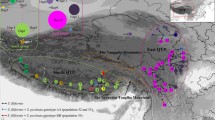Abstract
To understand the speciation process of Salvia isensis (Lamiaceae), a species endemic to a special environment (serpentine areas in the Ise-Tokai district, central Honshu, Japan), chloroplast DNA (cpDNA) and nuclear ribosomal DNA (nrDNA) were employed to analyze the phylogenetic relationships of S. isensis with related species in Japan. Allozymic polymorphisms were also used to analyze genetic relationships among Salvia species. A contradiction in the phylogenetic positions of species studied was detected when phylogenetic trees were constructed using cpDNA or nrDNA, i.e., S. isensis was a sister to the other species in phylogenetic trees generated from cpDNA, while S. japonica was a sister to the other species in the case of nrDNA. Genetic relationships between Salvia species estimated from allozymic polymorphisms did not contradict to the topology for nrDNA. Using the present results, the speciation process of S. isensis is discussed with regard to introgressive gene exchanges between related species.



Similar content being viewed by others
References
Baldwin BG (2005) Origin of the serpentine-endemic herb Layia discoidea from the widespread L. glandulosa (Compositae). Evolution 59:2473–2479
Blattner FR (1999) Direct amplification of the entire ITS region from pure preserved plant material using recombinant PCR. Biotechniques 29:1180–1186
Doyle JJ, Doyle JD (1987) A rapid DNA isolation procedure for small quantities of fresh leaf tissue. Phytochem Bull 19:11–15
Farris JS, Kallersjo M, Kluge AG, Bult C (1994) Testing significance of incongruence. Cladistics 10:315–319
Felsenstein J (1985) Confidence limits on phylogenies: an approach using the bootstrap. Evolution 39:783–791
Funamoto T, Zushi M, Harana T, Nakamura T (2000) Comparative karyomorphology of the Japanese species of Salvia L. (Lamiaceae). J Phytogeo Tax 48:11–18
Hall BG (2005) Phylogenetic trees made easy, how-to manual for molecular biologists. Sinauer, Sunderland
Hasebe M, Omori T, Nakazawa M (1994) RbcL gene sequences provide evidence for the evolutionary lineages of leptosprangiate ferns. Proc Natl Acad Sci USA 91:5730–5734
Heiser CB (1973) Introgression re-examined. Bot Rev 39:347–366
Kephart SR (1990) Starch gel electrophoresis of plant isozymes: a comparative analysis of techniques. Am J Bot 77:693–712
Mayer MS, Soltis PS, Soltis DE (1994) The evolution of the Streptanthus glandulosus complex (Cruciferae): genetic divergence and gene flow in serpentine endemics. Am J Bot 81:1288–1299
Mickevich MF, Farris JS (1981) The implications of congruence in Menidia. Syst Zool 30:351–370
Murata G, Yamazaki T (1993) Salvia L. In: Iwatsuki K, Yamazaki T, Boufford DE, Ohba H (eds) Flora of Japan IIIa. Kodansha, Tokyo, pp 302–307
Nakai G (1950) On Salvia japonica and S. lutescens (in Japanese). Acta Phytotax Geobot 14:63–66
Nei M (1978) Estimation of average heterozygosity and genetic distance from a small number of individuals. Genetics 89:583–590
Okada H (1984) Polyphyletic allopolyploid origin of Ranunculus cantoniensis (4×) from R. silerifolius (2×) × R. chinensis (2×). Plant Syst Evol 148:89–102
Pamilo P, Nei M (1988) Relationship between gene trees and species trees. Mol Biol Evol 5:568–583
Pepper AE, Norwood LE (2001) Evolution of Caulanthus amplexicaulis var. barbarae (Brassicaceae), a rare serpentine endemic plant—a molecular phylogenetic perspective. Am J Bot 88:1479–1489
Rieseberg LH, Soltis DE, Palmer JD (1988) A molecular reexamination of introgression between Helianthus annuus and H. bolanderi (Compositae). Evolution 42:227–238
Rohlf FJ (2000) NTSYS, Numerical Taxonomy and Multivariate Analysis System, version 2.0.2j. Applied Biostatistics, New York
Saitou N, Nei M (1987) The neighbor-joining method: a new method for reconstructing phylogenetic trees. Mol Biol Evol 4:406–425
Shield CR, Orton TJ, Stuber CW (1983) An outline general resource needs an procedures for the electrophoretic separation of active enzymes from plant tissue. In: Tanksley SD, Orton TJ (eds) Isozyme in plant genetics and breeding, part A, B. Elsevier, Amsterdam, pp 443–468
Shiraishi S (1988) Inheritance of isozyme variations in Japanese black pine, Pinus thunbergii Parl. Silvae Genet 37:93–100
Soltis DE, Hauffler CH, Darrow DC, Gastony DC (1983) Starch gel electrophoresis of ferns: a compilation of grinding buffers, gel and electrode buffers, and staining schedules. Am Fern J 73:9–27
Swofford D (2002) PAUP 3.1.1: phylogenetic analysis using parsimony. III: Illinois Natural History Survey, Champaign
Syamsuardi, Okada H (2002) Genetic diversity and genetic structure of populations of Ranunculus japonicus Thunb. (Ranunculaceae). Plant Species Biol 17:59–69
Takano A, Okada H (2002) Multiple occurrences of triploid formation in Globba (Zingiberaceae) from molecular evidence. Plant Syst Evol 230:143–159
Walker JB, Sytsma KJ, Treutlein J, Wink M (2004) Salvia (Lamiaceae) is not monophyletic: implications for the systematics, radiation, and ecological specializations of Salvia and tribe Mentheae. Am J Bot 91:1115–1125
Yeh FC, Yang R, Boyle T (1999) POPGENE version 31; Microsoft window-based freeware for Population Genetic Analysis, Alberta: Alberta University and Center for International Forestry Research, USA
Yoo K-O, Lowry PP, Wen J (2002) Discordance of chloroplast and nuclear ribosomal DNA data in Osmorhiza (Apiaceae). Am J Bot 89:966–971
Acknowledgments
We wish to express our gratitude to Dr. M.N. Tamura (Botanical Gardens, Osaka City University) and Dr. J. Yamashita (Okayama University) for comments on this manuscript, and to Prof. Dr. H. Tsukaya (University of Tokyo), Dr. G. Seto (Osaka Museum of Natural History), Ms. S. Onoue (Kashiwara city), and Mr. M. Horiuchi (Katano city) for their help in obtaining materials, to Prof. Dr. M. Kato (University of Tokyo) for permission to use facilities, to Dr. Y. Kita (University of Tokyo) for technical help, and to Mr. H. Yamada for his technical support using PAUP*. We also acknowledge anonymous reviewers for valuable comments to improve this manuscript.
Author information
Authors and Affiliations
Corresponding author
Electronic supplementary material
Below is the link to the electronic supplementary material.
Rights and permissions
About this article
Cite this article
Sudarmono, Okada, H. Speciation process of Salvia isensis (Lamiaceae), a species endemic to serpentine areas in the Ise-Tokai district, Japan, from the viewpoint of the contradictory phylogenetic trees generated from chloroplast and nuclear DNA. J Plant Res 120, 483–490 (2007). https://doi.org/10.1007/s10265-007-0075-2
Received:
Accepted:
Published:
Issue Date:
DOI: https://doi.org/10.1007/s10265-007-0075-2




